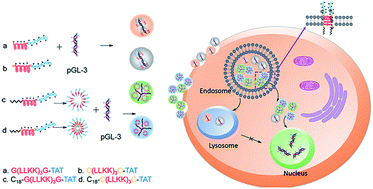Peptide amphiphiles with multifunctional fragments promoting cellular uptake and endosomal escape as efficient gene vectors†
Abstract
To overcome barriers associated with gene delivery, a series of peptides consisting of multifunctional fragments, including a cationic amphiphilic α-helical antimicrobial peptide (AMP), a cell penetrating peptide (CPP), TAT, a stearyl moiety, and cysteine residues, were designed and synthesized for evaluation as non-viral gene vectors. TAT and AMP segments were utilized to mediate cellular uptake and endosomal escape, respectively. Stearyl moieties provide an intramolecular hydrophobic environment to promote AMPs to form an α-helical conformation in PBS, and this is beneficial for DNA binding, cellular uptake, and endosomal escape. The α-helical content of the peptides, as well as the particle size, zeta potential, and morphology of the peptide/DNA complexes, was characterized. Fluorescence activated cell sorting (FACS) and confocal microscopy data showed that the peptides were able to efficiently translocate a pGL3 control plasmid across the plasma membrane via endocytosis, and then they successfully evaded endosomal entrapment and possible metabolic degradation. Moreover, one of the peptide vectors exhibited a high transfection efficiency similar to that of Lipofectamine 2000, concomitant with lower cytotoxicity. Overall, a combination of the four functional segments tested was used to generate a non-viral gene vector that synergistically promoted cellular uptake, endosomal escape, and gene expression.


 Please wait while we load your content...
Please wait while we load your content...